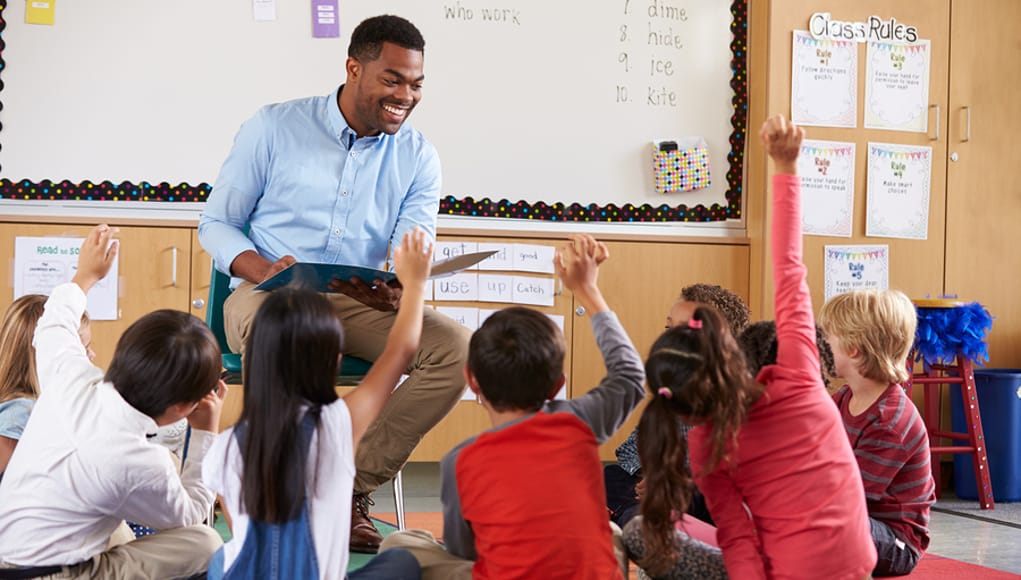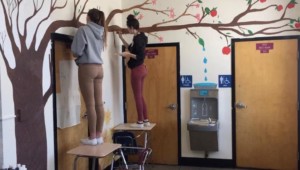Deeper Learning: What We Know So Far

Higher expectations, better measures and equity-ensuring accountability all sounded good in their own right, but bundled as standards-based reform and supercharged by NCLB, a bunch of unintended consequences swamped American education and resulted in a lot of thin, scripted, mind numbing test-prep. Deeper Learning is what the standards movement missed.
Engaging learners in authentic and extended tasks causes deeper learning–it’s what Ted Sizer called “helping young people learn to use their minds well.”
What do we know about teaching for deeper learning? We know it’s working.
Teaching that focuses on the development of the six deeper learning competencies (mastering core academic content, thinking critically and solving complex problems, working collaboratively, communicate effectively, learning how to learn and developing academic mindsets–see this image, from AIR) has proven to yield increased graduation rates, more engaged and advanced thinkers and increased equitability in opportunities to access high-quality learning experiences across schools in the U.S.
While still standards-aligned, the opportunity for students to investigate, tackle complex and real-world problems and develop academic persistence is the direction we should be taking K-12 education. Educators who are dedicated to deeper learning outcomes prove this to be true by daily are gleaning insights and evidence that it is working.
With support from the Hewlett Foundation, the Deeper Learning movement has grown from a handful of committed leaders and educators to thousands of dedicated schools and even the development of a Deeper Learning Equity Fellowship Program. Kaleb Rashad, Director of High Tech High, says that he is so enthused to see more educators focus on the six deeper learning six competencies (see below), but really encourages us to remember that is about the three cogs of “how students work with content, work with colleagues and work with themselves.” Deeper learning goes far beyond defining what these competencies are and is more about helping students grow, thrive and flourish in meaningful ways.
When you go into a deeper learning school, you’ll find yourself saying how awesome the students are and how positively charged educators seem. When you talk to educators and students engaged in deeper learning, they see more than traditional measures–they see quality work product resulting from student engagement, reflection and a culture of revision. For others new to deeper learning or looking for support, outcome evaluations lends fuel to their work.
As Hewlett’s Marc Chun said at the Deeper Learning Conference this year, “We don’t want deeper learning to just be kindling or a flame that goes out after a year. We want an eternal flame that keeps burning and grows sustainability across states and in schools.”
Make #NPDL an eternal flame, not fireworks or fires. #DeepLearning #DeeperLearning pic.twitter.com/IKXIRH8d3v
— Marc Chun (@HFMarcChun) May 2, 2017
The Research
Walk into a school that is committed to deeper learning and you’ll see evidence of the impact plastered on the walls through incredible products, hear stories from students and educators about how refreshed and recharged they are and feel the deeper learning energy and engagement. Over the last several years, organizations have been paying attention to these impacts. Let’s take a look at what we know so far:
Increased Student Engagement and School Satisfaction
- Teacher leadership & deeper learning for all students: “That has stuck with me, how I can be a catalyst for change” and more quotes are shared from Barnett Berry’s discussions with students that illustrate their deeper learning school environments have been positive in helping them feel connected and engaged.
- How Deeper Learning and 21st Century Skills Influenced One Suburban District’s Transition to 1:1 Student Technology: Personalized learning and a focus on deeper learning increased student performance and engagement in this district. 1:1 technology and the appropriate infrastructure and supports to encourage deeper learning proved to help students be more engaged and improved their performance.
- 2016 New Tech Network Annual Impact Report and the Research Summary of New Tech Network Evaluation Report: Project Years 1 (2013-14), 2 (2014-15), and 3 (2015-16): New Tech Network students, in addition to higher graduation and college persistence rates, grow 61% more in higher order thinking skills between freshman and senior years than a comparison group. Students rank their school in 90th percentile for peer relationships, meaning the degree to which they feel they have supportive, collaborative relationships with their classmates. 87% of surveyed New Tech Network elementary-aged students report feeling encouraged to be a strong leader and that they have positive feelings regarding their school.
Increased Graduation Rates and College Enrollment
- Post-secondary Outcomes of Innovative High Schools: The Big Picture Longitudinal Study: “The first BPL high school opened in Providence, Rhode Island in 1996, and
the first class graduated in 2000 with a 96% high school graduation rate and 98% college acceptance record.”
- Leaping the College-Ready Gap: What Can Be Learned from Schools That Focus on Deeper Learning: “Regardless of their prior level of academic achievement, students attained higher standardized test scores on both state assessments and the OECD PISA-based test. Both assessments measure core content knowledge and problem-solving skills. Students are more likely to graduate from high school on time than students in comparison schools. Graduates are more likely to enroll in four-year colleges and enroll in more selective institutions. Students reported higher levels of collaborative skills, academic engagement, and motivation to learn compared with their peers in schools that were not part of the deeper learning network.”
- Deeper Learning and College Attendance: What Happens After High School?: “Students who attended network high schools were significantly more likely to enroll in college than were students in non-network high schools. Roughly 53 percent of students who attended network high schools in the ninth grade enrolled in college by the end of 2014, compared to 50 percent of students in non-network schools.”
“Twenty-two percent of students who attended network high schools enrolled in four-year institutions, compared to 18 percent of students in non-network schools. For selective four-year schools—defined as four-year institutions where more than 80 percent of incoming freshmen are full-time students and where admissions test scores place the institution above the 40th percentile of postsecondary institutions—the research found that 9 percent of students from network schools and 7 percent from non-network schools enrolled.”
- Graduation Advantage Persists for Students in Deeper Learning Network High Schools: “Consistent with the findings from the original Study of Deeper Learning, newly completed analyses including additional school pairs and an additional cohort of students find a graduation rate advantage of 8 percentage points for students in participating deeper learning network high schools compared with similar students in matched non-network high schools.”
- Equal Opportunity for Deeper Learning: “Schools that engage low-income and minority students in deeper learning have stronger academic outcomes, better attendance and student behavior, lower dropout rates, higher graduation rates, and higher rates of college attendance and perseverance than comparison schools serving similar students. These schools, which operationalize simultaneous commitments to equity and deeper learning, provide: Supports for educator learning through opportunities for reflection, collaboration, and leadership, as well as professional development.”
- EL Education – By the Numbers and Mathematica Policy Research: Evaluation of Expeditionary Learning Middle Schools: “After three years of attending a school in the EL Education network, students gain an average of 10 months in math achievement and 7 months in reading achievement.”
Improved Interpersonal and Intrapersonal Skills
- Findings From the Study of Deeper Learning: Opportunities and Outcomes: Students who attended participating network schools reported more positive interpersonal and intrapersonal outcomes than students who attended non-network schools.
- Looking Under the Hood of Competency-Based Education: The Relationship Between Competency-Based Education Practices and Students’ Learning Skills, Behaviors, and Dispositions: “Intrinsic motivation (i.e., students’ possession of an internal drive to engage in their education) was the measured learning capacity most strongly associated with competency-based education practices.”
- Deeper Learning: Improving Student Outcomes for College, Career, and Civic Life: Students in the deeper learning network of schools studied had higher self-reported levels of collaborative skills, academic engagement, motivation to learn, and self-efficacy. Overall, there was improvement in interpersonal and intrapersonal skills.
Self-Efficacy and Agency Around Student-Centered Teaching Related to Deeper Learning Outcomes and Opportunities
- Teacher leadership & deeper learning for all students: In the report, Berry shares how teacher leadership and agency is key to spreading deeper learning for all students. He shares lessons learned from investigating the past 30 years of teacher leadership and suggestions for next steps and possible policy improvements.
- School Features and Student Opportunities for Deeper Learning What Makes a Difference?: Researchers evaluated “whether there were certain school features that facilitated a school’s ability to provide deeper learning opportunities.” Key findings: “Across the network schools, student-centered beliefs about teaching and teachers’ self-efficacy for teaching were the features most strongly and consistently related to student deeper learning opportunities. By contrast, teacher-centered beliefs about teaching were negatively related to student opportunities.”
- Lighting the Path to Personalized Learning: This report tells the story of 14 schools across the country that are breaking through the traditional model of school to present students with next gen learning experiences that are personalized, engaging and focused on deeper learning. Lessons learned from educators at these schools highlight that their self-efficacy and commitment to high expectations played into the resulting deeper learning outcomes.
For more, check out a comprehensive list of deeper learning studies and reports from the Great Lakes & Midwest Regional Deeper Learning Initiative and see the High Tech High Graduate School for Education’s peer-reviewed journal about adult learning, unBoxed.
What’s Next
As more schools refocus or shift their own practices to be more deeper learning-aligned, outcomes and indicators of success will be identified. The continued conversations, connections and classroom work are what will keep this movement an “eternal flame” and not just a temporary campfire. This requires a focus on sharing the work, equity and scale.
Sharing
As mentioned, while the numbers and quantitative impacts are outstanding, deeper learning also really just brings out the awesome in students and educators. We need to keep capturing their stories and artifacts from their learning. Two examples to do this are the Share Your Learning project and the EL Education Models of Excellence site. We, too, will continue to highlight stories and voices on Getting Smart.
Scale
Scaling Deeper Learning practices to more classrooms across the country demands more access to rich resources, tools and strategies. This may include digital resources, examples and expertise available to any educator interested in starting this work. Fortunately, the Hewlett Foundation is exploring this issues and investigating how to best scale deeper learning.
Equity
Each student has a unique background, life experiences, learning goals, and social and emotional needs. Educators employing deeper learning strategies and facilitation techniques daily are providing each of their students with the opportunity to meet these needs and surpass their goals. Many educators focused on deeper learning work to identify what each student wants from his or her education and helps them achieve that through shifting their facilitation and feedback on an individual student-to-student basis. Without access to deeper learning environments, many students remain in doldrum and non-personalized classroom environments. All students ought to be encouraged to dig deep, reveal their own truths, get to know themselves and others, and understand how they can contribute to and thrive in the world. There are currently many schools using grant funding or district dollars to focus on this work, but how can we ensure in the absence of deeper-learning-specific funding that teachers still see the possibilities to help students work towards these outcomes?
For more, see:
- Deeper Learning for Every Student Every Day
- Structures Drive Behavior: Right is Magic, Wrong is Deadly
- To Design Deep Learning, Look to Enrichment and Its Ancient Wisdom
Stay in-the-know with all things EdTech and innovations in learning by signing up to receive the weekly Smart Update. This post includes mentions of a Getting Smart partner. For a full list of partners, affiliate organizations and all other disclosures, please see our Partner page.








0 Comments
Leave a Comment
Your email address will not be published. All fields are required.